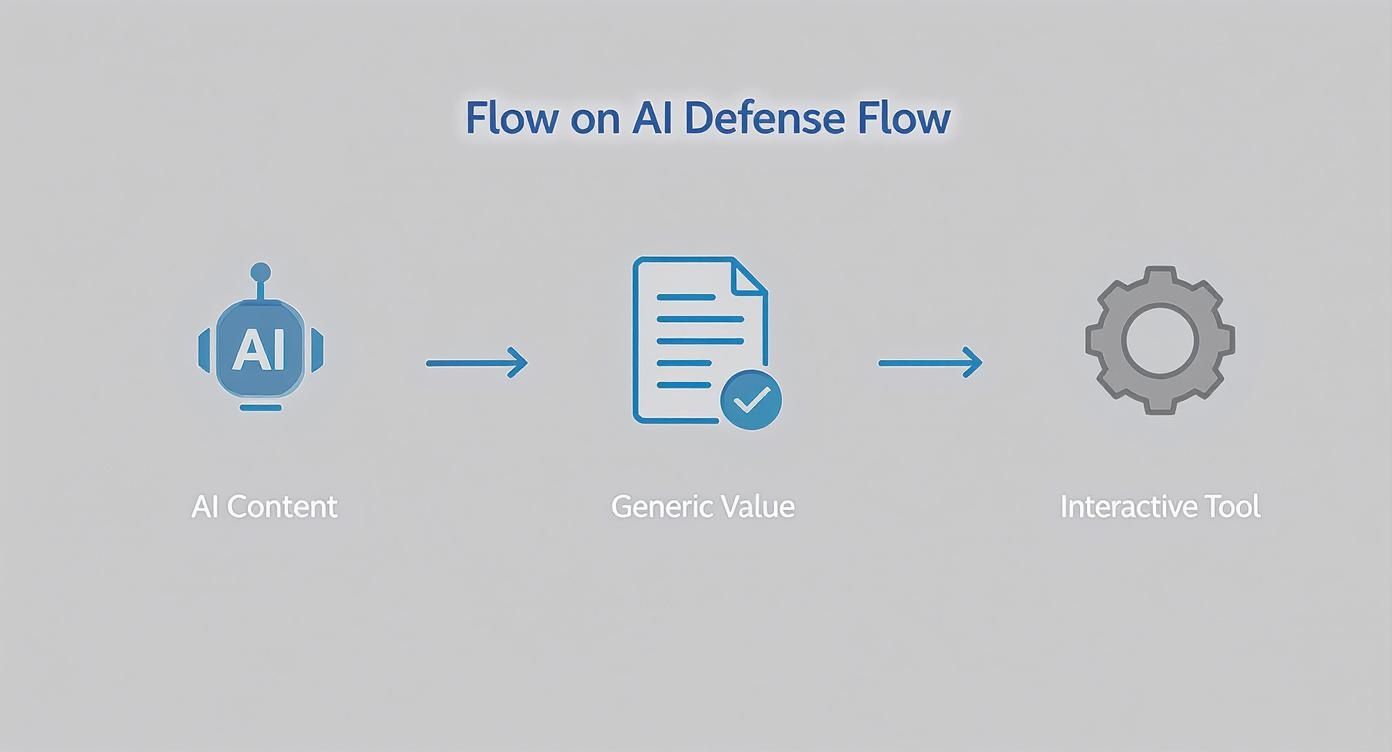Engineering as Marketing: The Indie Hacker's Secret Weapon
Discover engineering as marketing, the powerful strategy indie hackers use to build tools that generate leads and thrive in the age of AI slop.

Imagine a marketing asset that works for you 24/7, builds immediate trust, and can’t be easily copied by AI. This is engineering as marketing, a powerful strategy savvy indie hackers are using to gain a serious advantage. It’s a secret technique they've been quietly using to outmaneuver bigger, slower competitors. It’s all about building small, genuinely useful tools that solve a real problem for your audience, instead of just churning out another blog post.
The Unfair Advantage Your Competitors Ignore

You feel the pressure. Every single day, you're expected to publish more content, run more ads, and just fight for a sliver of attention in an incredibly crowded space. The real problem is, most of that effort feels temporary. Your content gets buried under the next wave of generic text almost as soon as you hit publish. It’s a soul-crushing cycle.
Engineering as marketing flips this entire model on its head. Instead of just telling people you have a solution, you actually show them by giving them a piece of it right upfront. Think of it as building a small, value-generating engine, rather than just writing another brochure.
This approach feels less like selling and more like helping. You establish yourself as a trusted authority from the very first interaction. You’re not just another voice shouting in the void; you’re a builder providing something tangible. As we'll dig into, the evidence is stacking up that tool-based marketing is killing traditional content marketing because it delivers immediate, hands-on value.
This strategy is your competitive moat in a world flooded with AI-generated text. While an algorithm can spit out an article in seconds, it can't yet design and build a unique, helpful tool that solves a specific user problem with precision.
The Power of Interactive Value
The core idea is simple but profound: you build something your ideal customer can actually use. This could be anything from a simple calculator to a niche-specific analyser or a template generator. The key is that it solves a real, nagging problem for them, right there on your website.
Why is this so damn effective?
- Demonstrates Expertise: A tool proves your competence in a way no blog post ever could. It screams, "I understand this problem so well, I built a solution for it."
- Builds Instant Trust: By providing genuine value before asking for anything, you create a powerful sense of goodwill and reciprocity. It’s a classic give-before-you-get.
- Generates Qualified Leads: The people who use your tool are, by definition, your target audience. They have the exact problem your main product solves.
Let's break down the difference between the old way and the new way.
Static Content vs Interactive Tools
| Attribute | Static Content (PDF Guide) | Interactive Tool (Calculator) |
|---|---|---|
| Value Delivery | Passive information | Active, personalised results |
| User Engagement | Low (read and forget) | High (input, interact, use) |
| Trust Building | Claims expertise | Demonstrates expertise |
| Lead Quality | Low (might never open PDF) | High (user has the exact problem) |
| Virality | Low (maybe a social share) | High (shared with teams, bookmarked) |
| Data Collection | Only captures an email | Gathers usage data and insights |
The table makes it pretty clear. While a PDF might get you an email address, an interactive tool gives you a pre-qualified lead who has already experienced a micro-version of the value you provide. This is a game-changer because even a simple tool can generate high-quality leads and consistent traffic for years.
Engineering your marketing is about using technical solutions to gain that edge. It’s no surprise that interactive product demos are the new sales superpower. These experiences create a powerful, hands-on connection that static content just can't compete with, making them a cornerstone of modern growth.
Why Our Brains Are Hardwired to Love Tools

Ever found yourself sucked into a simple online quiz, only to look up and realise you've spent way more time on it than you planned? Now, compare that to the last ebook you downloaded. If you’re like most of us, that PDF is probably collecting digital dust in some forgotten folder.
This isn't a lapse in self-discipline. It’s a dead-simple reflection of how our brains are wired.
For thousands of years, our survival has been tied to discovering, making, and using tools. From the first sharpened stone to the mind-boggling machinery of today, tools have always meant progress, efficiency, and a bit of control over our chaotic world. This deep-seated instinct to find things that make life easier is still kicking, even in the digital age. We're always hunting for things that can help us.
That’s the psychological engine behind engineering as marketing. An interactive tool plugs directly into this ancient human drive. It's not just passive information; it's a thing you can use to hit a goal, even a tiny one. It satisfies that primal hunt for utility.
The Power of the "Aha!" Moment
When someone uses your tool—be it a calculator, an analyser, or a simple generator—they aren't just reading. They are doing. They punch in their own data and get an immediate, personalised result back.
This is where the magic happens. That interaction triggers a satisfying ‘Aha!’ moment.
That flash of insight delivers a small but potent dopamine hit in the brain. It's a little neurochemical reward for solving a puzzle or learning something new. A static PDF just can't compete with that. It gives you information, but the tool gives you an experience.
This instant gratification accomplishes a few crucial things:
- It creates a strong, positive feeling about your brand.
- It builds a foundation of trust because you delivered real value, right away.
- It makes people far more likely to stick around and see what else you've got.
Think about it: a tool gives you a direct answer, while a guide just gives you the homework to find the answer. One feels like a gift, the other feels like a chore. This is why engineering as marketing feels so much more helpful and authentic.
The best part? This field is still wide open. While your competitors are stuck on the content hamster wheel, churning out another blog post, you can be building assets that connect with people on a much deeper, almost primal level.
The competition is ridiculously sparse, mostly clustered around crowded spaces like SEO audit tools. For almost every other niche, the opportunity to build the definitive, go-to tool is massive. You can be first.
Your Defence Against AI Content Overload
The old marketing playbook is getting crushed. If your whole strategy is leaning on SEO-driven blog posts, you're in for a rough ride. The internet is already drowning in a sea of AI-generated content, and the value of another generic article is plummeting.
To stand out in this new world, you need something more—something an AI can’t just spit out on command. This is where engineering as marketing becomes your most powerful, defensible move. It’s your competitive moat.
Sure, an AI can write a thousand-word article on pretty much any topic. What it can't do is design and build a genuinely useful, interactive tool that solves a very specific problem for your ideal customer. Building these small, helpful engines is the next evolution of marketing. It's how you prove your expertise instead of just talking about it.
Building a Sustainable Marketing Asset
A well-built tool isn't just another piece of content; it's a sustainable source of leads that doesn’t live or die by the whims of search engine algorithms. It pulls people in because it offers real, immediate value. This is a huge shift from chasing keywords to creating resources people can't live without.
The real magic here is creating an asset that works for you 24/7. It doesn’t get buried by tomorrow’s content avalanche; it becomes a go-to resource that people bookmark, share, and remember.
This thinking transforms your marketing from a recurring cost into a long-term investment. You're no longer just renting attention with ads or content. You're building an asset that actually appreciates in value as more people find and use it. You’re moving from the temporary to the permanent.
Escaping the Content Treadmill
The pressure to constantly feed the content machine is brutal. You write, you publish, you promote, and then you do it all over again tomorrow. It’s exhausting. An interactive tool, on the other hand, is your ticket off this hamster wheel.
- It has a much longer shelf-life: A useful calculator or analyser can stay relevant for years with just a few minor tweaks.
- It brings in higher-quality leads: The people engaging with your tool aren’t just browsing; they're actively trying to solve the exact problem your business fixes.
- It provides undeniable value: You’re not just throwing information at them. You're helping them achieve a specific outcome, which creates a killer first impression.
The field for this is still wide open. While everyone's busy building yet another SEO audit tool, countless other niches are just waiting for someone to build a simple tool that solves a common headache. This is your chance to build something genuinely valuable that AI can’t touch.
How to Build Your First Marketing Engine
So, the idea of building a software tool probably sounds complicated and expensive. Something reserved for big companies with massive engineering teams, right?
That’s one of the biggest myths holding marketers back. You don’t need a huge team to win with engineering as marketing. You just need to solve one small, really annoying problem for your customers.
This is your secret weapon, especially now that AI is turning text-based content into a commodity. While your competitors are busy churning out generic blog posts, you can be building a genuine asset that gives people immediate, tangible value.
The best part? The field is still wide open. There’s surprisingly little competition once you get outside of crowded niches like SEO audit tools.
Pinpoint a Small, Painful Problem
Your first step isn't to dream up a complex application. It’s to find a tiny, repetitive task or calculation that your ideal customer absolutely hates doing by hand. Listen to what they’re asking over and over again on sales calls or social media.
- What simple calculations are they plugging into spreadsheets?
- What checklists do they keep recreating from scratch?
- What piece of data do they have to look up again and again?
The goal is to find a "splinter," not a "broken leg." A social media manager doesn't need another full-blown analytics suite; they might just need a simple tool to spit out post ideas for an upcoming holiday. An e-commerce owner doesn’t need a whole ERP system; they might just need a quick calculator to figure out profit margins on a new product.
This is the strategic shift you need to make: move away from generic, AI-driven content and toward interactive tools that deliver unique value.

As AI makes content creation easy for everyone, the real way to stand out is by building something genuinely useful and interactive—something a language model can't just replicate.
100% Free Lead Magnet Audit
Our AI analyzes your website and delivers custom growth strategies in seconds.
Define Your Minimum Viable Tool
Once you’ve found the problem, figure out the absolute smallest version of a tool that can solve it. This is your 'minimum viable tool' (MVT). It should deliver one quick win, and that's it. Forget about user accounts, fancy dashboards, or a dozen features.
Usefulness is far more important than complexity.
Your MVT should:
- Solve one specific problem: It does one thing, and it does it incredibly well.
- Provide instant gratification: The user gets their answer in seconds. No waiting.
- Be incredibly simple to use: If it needs instructions, it's too complicated.
For example, if your audience struggles with pricing, your MVT could be a simple profit margin calculator—just three input fields and one clear output. Done.
Choose Your Technology
Look, you don't need to be a developer to build your first marketing engine. There are incredible no-code and low-code platforms out there that let you bring ideas to life visually.
Platforms like Bubble or Webflow can handle surprisingly complex logic without you ever writing a single line of code. Heck, even a well-designed spreadsheet or a simple script can be the foundation of a powerful tool.
The heart of any marketing engine is a well-crafted landing page. Learning the art of creating a high-converting landing page that sells can make or break your tool's success. A brilliant tool with a lousy landing page will just fail, so don't overlook the user experience.
You can see how all these pieces fit together in our complete guide to building a lead generation system. The entire point is to create something that gives the user immediate value while generating a highly qualified lead for your business.
Simple Tools Driving Massive Growth in the Wild
Theory is great, but seeing this strategy play out in the real world is what really makes it click.
The best part about engineering as marketing? It’s not just for massive companies with nine-figure budgets. Some of the most effective tools were built by indie hackers and small teams who simply spotted a painful problem and built a solution.
The field is still shockingly wide open. This is especially true when you look at the broader engineering industry. For instance, while the traditional engineering services sector is booming—with recent reports showing an 11.8% revenue jump in Delaware alone—there’s zero mention of using those skills for marketing.
The opportunity to fuse engineering talent with marketing needs is an almost entirely untapped market, as you can see by reading the full industry assessment.
The Titans of Tool-Based Marketing
Of course, we have to start with the classics. These are the tools that proved the model worked and paved the way for the rest of us. They show how a simple, focused utility can become a company’s most powerful marketing asset.
- HubSpot's Website Grader: This is the quintessential example. It does one thing: it gives your website a score. It’s simple, delivers instant value, and perfectly introduces the very problems HubSpot’s main products solve.
- CoSchedule's Headline Analyzer: Another masterpiece of simplicity. It helps marketers write better headlines by scoring them on clarity, emotion, and power. It's a daily-use tool for their target audience, keeping CoSchedule top-of-mind.
Here's a look at the beautifully simple interface of HubSpot's legendary tool.
The screenshot shows how the tool offers a clear, single call-to-action—enter your website and email—to get immediate, tangible value. That’s the core principle of this entire strategy.
Indie Hackers Punching Above Their Weight
But this isn't just a game for giants. The most exciting developments are coming from smaller players building incredibly useful, niche tools that quietly drive thousands of leads. They prove you don't need a huge team, just a deep understanding of one specific problem.
This is where your unfair advantage lies. While big companies focus on broad appeal, you can create a hyper-specific tool for a niche audience that feels like it was custom-built just for them.
Think smaller. Instead of a general-purpose SEO tool, what about a tool that only analyses product descriptions for e-commerce sites? Instead of a full-blown project management suite, how about a simple calculator that estimates the time savings of a particular workflow?
These focused tools, much like the ones you can build with inspiration from online quiz makers, can generate incredibly qualified leads by solving a very specific pain point.
The secret is that the competition is sparse. Most marketers are still stuck on the content treadmill, fighting over the same keywords. You have the chance to build a real, defensible asset that AI can't easily replicate, establishing yourself as the go-to resource in your corner of the world.
From Guesswork to Growth: Your Lead Magnet Audit
You did the work. You built a lead magnet. Now for the question you’ve been avoiding: is it actually doing anything?
Too often, we launch a PDF, cross our fingers, and hope for the best. We never really dig into whether it’s pulling its weight. This is a losing game. Hope isn’t a strategy.
This is where thinking like an engineer completely changes the game. Your lead magnet isn’t just a piece of content; it’s a system. A system you can measure, tweak, and perfect.
Shifting From Content to a Marketing Engine
To get past the guesswork, you have to audit your lead generation strategy to see its real impact. Are people just grabbing your PDF and ghosting you forever? Or is it genuinely helping them and making them curious about your actual product?
Making that leap—from static content to a powerful marketing engine—requires data, not assumptions. You need to know what’s working and what’s a complete waste of time.
Most marketers are stuck shipping content and hoping for results. Real growth comes from shipping, measuring, and then iterating on what you've built. An unaudited lead magnet is just a shot in the dark.
If you’re stuck, I built a tool to help. You can use our free lead magnet audit tool, Magnethive, which generates a comprehensive report with 3 AI-powered lead magnet ideas, analysis of your current lead magnet (if you have one), and shows ROI impact. It is 100% free to use and can give you a clear, data-driven path forward.
This is what engineering as marketing looks like in the wild. It’s how you stop guessing and start building a predictable machine for attracting high-quality leads.
Got Questions?
You can probably see how powerful this is, but it’s a big shift from just writing another blog post. It's totally normal to have a few questions before you jump in. Let's clear up the common ones.
Do I Need to Be a Developer to Pull This Off?
Absolutely not. This is the biggest misconception.
While knowing how to code is a nice bonus, you don't need it. Many of the most successful marketing tools were built on powerful no-code platforms like Bubble or Webflow. Some are even just fancy spreadsheet templates.
The real skill here isn't writing code—it’s finding a small, nagging problem your audience deals with and building a dead-simple solution for it. The focus is always on the problem, not the programming language.
Okay, But How Do I Come Up with a Good Tool Idea?
It's easier than you think. Start by becoming an obsessive listener.
Tune into the questions your audience asks over and over again. Look in online communities, listen carefully on sales calls, and watch what people are complaining about on social media.
- What are they constantly trying to figure out?
- What tiny calculations are they doing on the back of a napkin?
- Are there any repetitive, soul-crushing tasks in their workflow you could automate?
Your best tool idea is almost never some complex, groundbreaking invention. It’s usually a simple fix for a common and persistent headache. The goal is to build something that makes them say, "Finally! I've been looking for something exactly like this."
How Does a Free Tool Actually Get Me Leads?
This is where the magic happens, and it's beautifully simple. You give away the core function of the tool for free, providing instant, real value.
Once the user gets their result—that "Aha!" moment—you offer to send them a more detailed report, save their progress, or unlock a few advanced features in exchange for their email.
Because you’ve already proven you can help them, they’re way more likely to hand over their contact details. It’s a value-first exchange, which is precisely why it converts so much better than a gated PDF.